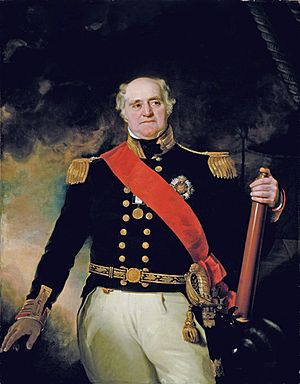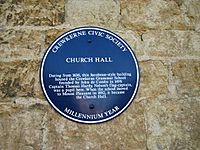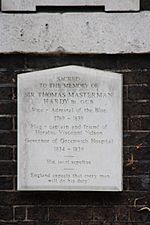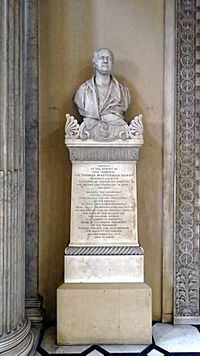Sir Thomas Hardy, 1st Baronet facts for kids
Quick facts for kids
Sir Thomas Hardy
|
|
|---|---|
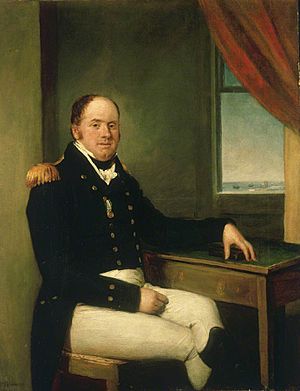
Hardy in 1809, by Domenico Pellegrini
|
|
| Born | 5 April 1769 Kingston Russell, Dorset, England |
| Died | 20 September 1839 (aged 70) Greenwich, London, England |
| Allegiance | |
| Service/ |
|
| Years of service | 1790–1839 |
| Rank | Vice-Admiral |
| Commands held | HMS Mutine HMS Vanguard HMS Foudroyant HMS Princess Charlotte HMS San Josef HMS St George HMS Isis HMS Amphion HMS Victory HMS Triumph HMS Barfleur HMS Ramillies HMS Princess Augusta South America Station Greenwich Hospital |
| Battles/wars | |
| Awards | Knight Grand Cross of the Order of the Bath |
Sir Thomas Masterman Hardy (born April 5, 1769 – died September 20, 1839) was a brave officer in the Royal Navy. He is most famous for being the flag captain (the captain of the admiral's ship) to Admiral Lord Nelson. Hardy commanded HMS Victory during the famous Battle of Trafalgar in October 1805.
During this battle, Nelson was badly wounded. His last words, "Kiss me, Hardy," were spoken to Sir Thomas. Hardy later became a very important naval leader, encouraging the use of new steam warships.
Contents
Thomas Hardy was born in Kingston Russell, Dorset, England. He was the second son of Joseph and Nanny Hardy. He joined the navy when he was just 12 years old, in November 1781. He served on a ship called HMS Helena. After a few months, he left to attend Crewkerne Grammar School. Even while at school, his name was kept on the navy's official lists.
Adventures in the Mediterranean
Hardy officially became a midshipman in 1790. He sailed to the Mediterranean in 1793. He became a second lieutenant on HMS Meleager.
In 1796, Hardy joined HMS Minerve. This is where he first met Horatio Nelson, who was a commodore at the time. During a fight with two Spanish ships, Hardy was sent to take over one of the captured enemy ships. However, the Spanish fleet appeared, and Hardy's ship was captured. Luckily, he was quickly exchanged for a Spanish captain and rejoined Nelson.
A few days later, a topman (a sailor who works high up in the rigging) fell overboard. Hardy went in a boat to rescue him. As enemy ships got closer, Nelson famously said, "By God, I'll not lose Hardy!" He ordered his ship to slow down, confusing the Spanish and allowing Hardy to return safely.
Leading Ships and the Battle of the Nile
In May 1797, Hardy was promoted to commander of HMS Mutine. His ship joined Nelson's fleet in 1798. They found Napoleon Bonaparte's fleet in Egypt. Nelson's fleet then destroyed the French ships at the Battle of the Nile in August 1798.
After this victory, Hardy was promoted to captain of Nelson's own ship, HMS Vanguard. In December 1798, Vanguard helped move King Ferdinand IV to safety in Sicily. Nelson later moved his flag to HMS Foudroyant in June 1799, and Hardy went with him. They helped restore the king's rule in Naples.
Baltic Sea and Copenhagen
After a break, Hardy took command of HMS San Josef in December 1800. He then became Nelson's flag captain again on HMS St George in February 1801. Nelson's fleet was sent to the Baltic Sea to deal with the Danes.
The night before the Battle of Copenhagen, Hardy was sent in a boat to measure the depth of the water around the Danish fleet. This was very important work. Even though his own ship was too large to join the main battle, Hardy's measurements helped the other ships avoid getting stuck.
Chasing the French Fleet
In 1802, Hardy was given command of HMS Amphion. Nelson joined him on this ship in May 1803. They later moved to the famous HMS Victory. Nelson's fleet then blockaded Toulon until April 1805.
When the French fleet escaped, Nelson and Hardy chased them all the way to the West Indies and back. This long chase showed their determination. They arrived back in Cádiz in September 1805, ready for the next big battle.
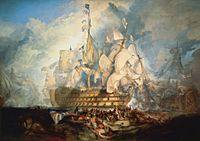
The Battle of Trafalgar
On October 21, 1805, Victory led the attack at the Battle of Trafalgar. Hardy was with Nelson on the deck. At one point, a piece of wood hit Hardy's shoe buckle. Nelson calmly said, "This is too warm work Hardy, to last for long."
Nelson was shot during the battle. As he lay dying below deck, Hardy stayed by his side. Hardy told Nelson that 14 or 15 enemy ships had surrendered. Nelson replied that he had "bargained for 20." In their last conversation, Nelson reminded Hardy to anchor the fleet. Nelson then asked Hardy to kiss him. Hardy kissed his cheek, and Nelson said, "Now I am satisfied, Thank God I have done my duty." Hardy then kissed Nelson's forehead. "God bless you Hardy" were Nelson's last words to him.
Victory was towed to Gibraltar for repairs. Hardy carried one of the banners at Nelson's funeral procession in January 1806.
Later Career and Achievements
Hardy was honored for his bravery and made a baronet in January 1806. He commanded HMS Triumph in North America. There, he married Anna Louisa Berkeley.
In 1812, Hardy returned to North America during the War of 1812. He led a successful attack on Fort Sullivan in Eastport, Maine. The American defenders surrendered without a fight. Hardy became very popular with the local people. He was made a Knight Commander of the Order of the Bath in 1815.
Hardy later became Commander-in-Chief of the South America Station in 1819. His job was to prevent Spain from interfering with new countries like Mexico and Argentina.
Admiral and Governor
Hardy was promoted to rear admiral in 1825. He then became the First Naval Lord in November 1830. This was a very important position in the navy. He encouraged the navy to start using new steam-powered warships.
In 1834, he became the Governor of Greenwich Hospital, a home for retired sailors. He was promoted to vice admiral in 1837.
Sir Thomas Hardy passed away in Greenwich on September 20, 1839. He is buried in the Greenwich Hospital Cemetery.
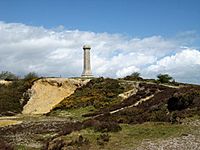
Family Life
On November 17, 1807, Hardy married Louisa Emily Anna Berkeley. They had three daughters:
- Louisa Georgina Hardy (born 1808)
- Emily Georgina Hardy (born 1809)
- Mary Charlotte Hardy (born 1813)
Hardy Monument
The Hardy Monument is a tall stone tower, about 72 feet (22 meters) high. It was built in 1844 on Dorset's Black Down hill to remember Sir Thomas Hardy. His family owned land nearby. The monument was placed where it could be seen from far away, even by ships at sea. It has been on navigation maps since 1846 and can be seen from 60 miles (97 km) away!
Honours and Awards
Sir Thomas Hardy received many important awards for his service:
- Knight Grand Cross of the Bath (GCB) – September 13, 1831
- Knight Commander of the Bath (KCB) – January 2, 1815
- Baronet – January 29, 1806


